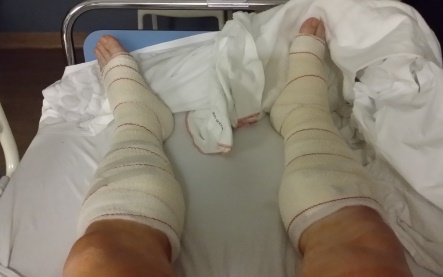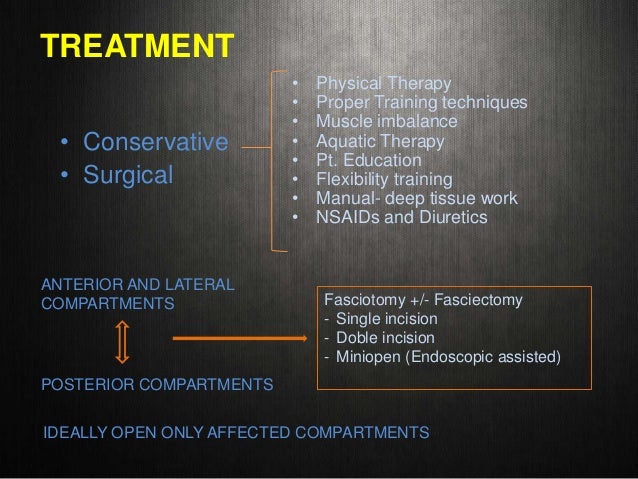Chronic Exertional Compartment Syndrome Physical Therapy
Chronic exertional compartment syndrome physical therapy. In the event that your case of compartment syndrome requires surgery either due to an acute injury or chronic condition postoperative physical therapy will be essential to a successful recovery. The onset of symptoms is related to specific. Chronic Exertional Compartment Syndrome CECS causes significant exercise related pain secondary to increased intra-compartmental pressure ICP in the lower extremities.
Many people are unwilling to stop running so they undergo surgery. Exercise that involves repeated movements such as walking running biking swimming playing tennis or jumping typically cause CCS. And the ante- rior compartment of the lower leg is affected most conimonly I 5.
ACS is caused by active bleeding or edema in a specific compartment usually as a result of fractures blunt force trauma and reperfusion injuries after acute arterial obstructions. Rehabilitation Guidelines Following Compartment Syndrome Release With Open Fasciotomy Chronic Exertional Compartment Syndrome CECS is a painful condition of the lower leg that affects many runners and other athletes involved in repetitive impact activities. Chronic exertional compartment syndrome CECS occurs when there is an increase in interstitial pressure within a non-compliant fascial compartment during exercise.
CECS is most often treated with surgery with minimal information available on. Physical therapy often does not help the problem go away completely. For many years the definitive treatment for exertional compartment syndrome has been release of the fascia around the involved compartment with surgical procedures such as a fasciectomy or a fasciotomy.
Chronic exertional compartment syndrome CECS first described in 1912 is a rare clinical diagnosis that occurs more frequently in the lower extremity than the upper extremity16 Lower-extremity CECS is most often observed in running athletes7 and marching military members810 Upper-extremity CECS is most commonly seen in rowers11 and professional motorcyclists51213 Although. The hallmark sign of CECS is a consistent onset of symptoms at a. Upper-extremity CECS is most commonly seen in rowers and professional motorcyclists.
Chronic exertional compartment syndrome CECS of the leg is a pathological condition often related to overuse in subject who engage repetitive physical activities. Chronic compartment syndrome develops over time usually due to excessive or inefficient exercise exertion. Fascial release is the mainstay.
The syndrome is often bilateral 41015. Chronic compartment syndrome develops over time usually due to excessive or inefficient exercise exertion.
Physical therapy often does not help the problem go away completely.
1Physical Therapy Beaumont Health Royal Oak USA. Chronic exertional compartment syndrome is a condition in which the muscles usually of the leg swell and cause the leg to become very tight within the fascia that make up the muscle compartments. What is Compartment Syndrome. ACS is caused by active bleeding or edema in a specific compartment usually as a result of fractures blunt force trauma and reperfusion injuries after acute arterial obstructions. Chronic compartment syndrome diagnosis is based on the history physical examination and exercise compartment pressures. Physical therapy can be effective to help identify the factors that may influence the development of compartment syndrome. The syndrome is often bilateral 41015. CECS is most often treated with surgery with minimal information available on. In the event that your case of compartment syndrome requires surgery either due to an acute injury or chronic condition postoperative physical therapy will be essential to a successful recovery.
Your physical therapist will be in close communication with your surgeon regarding the nature of your procedure expected timelines for healing and your progress during rehabilitation. What is Compartment Syndrome. The hallmark sign of CECS is a consistent onset of symptoms at a. And the ante- rior compartment of the lower leg is affected most conimonly I 5. CECS is most often treated with surgery with minimal information available on. Our senior physiotherapists can be effective to help identify the factors that may influence the development of compartment syndrome. Chronic exertional compartment syndrome CECS first described in 1912 is a rare clinical diagnosis that occurs more frequently in the lower extremity than the upper extremity16 Lower-extremity CECS is most often observed in running athletes7 and marching military members810 Upper-extremity CECS is most commonly seen in rowers11 and professional motorcyclists51213 Although.

























/175503428-56a6d96d3df78cf772908b91.jpg)

















Post a Comment for "Chronic Exertional Compartment Syndrome Physical Therapy"